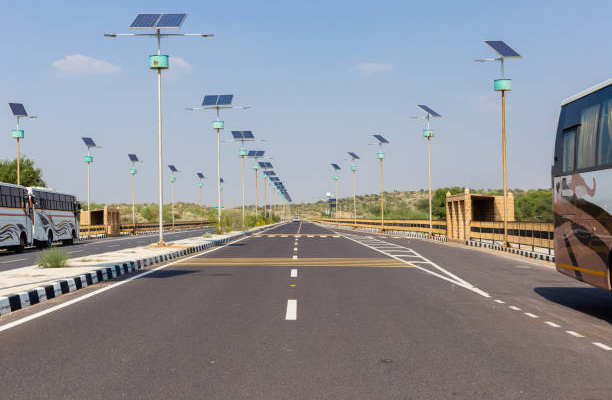Solar street lights are gaining popularity as they provide high performance at relatively lower operational costs. They provide increased functionality at reduced cost. Opportunity-driven urban developers are further advanced by automating solar street light systems as they enhance efficiency and reduction of expenditure. Entrepreneurs who engage with municipalities, planners or even contractors directly feel the impact of the savings that are provided in purchasing these solar light systems.
This article explains how access to wholesale solar LED street lights can aid significantly in controlling expenditures in public and business lighting projects.
Defining the Automatic Solar Street Light System
Automatic solar street light systems constitute an independent unit composed of a solar powered, outdoor lighting system integrated with intelligent control systems. Generally, such systems hold LED luminaires, photovoltaic panels, infrared sensors, rechargeable batteries, and dusk to dawn automation.
What distinguishes these systems from others is the lack of human control. They are installed to automatically charge during the day and turn on at night. Many modern units enhance their efficiency by adjusting brightness based on activity levels or ambient light conditions.
These systems become cost-effective when procured from a wholesale solar LED street light vendor since minimal maintenance coupled with wide area coverage scalability makes them ideal for large projects.
Major Operational Cost Drivers in Traditional Street Lighting
Analyzing autonomous solar lights in depth, it is crucial to understand the value traditional grid-powered lights bring to the table in terms of expenses:
- Electricity costs: Lighting that relies on grid power results in constant expenditure on utility payments.
- Installation: Trenches, transformer cable laydown, and underground cabling is labor intensive and equipment costly.
- Maintenance: Regular inspection and servicing of bulbs, wiring, and electrical faults is integral to grid-connected streetlight upkeep.
- Downtime: Lighting supplied with power and equipment can fail or cease functioning mid-operation, which increases liability and safety concerns.
Along with these hidden costs, the expenses incurred with grid lighting systems that are incurred from time to time make the entire setup unreasonably expensive for multi-branch commercial entities or municipalities.
Ways How Automatic Solar Street Lights Cut Expenses Over Time
Switching to automatic solar street light systems offers savings in several areas, both immediate and over a longer term:
No Perpetual Electricity Expenses
Solar powered lighting is not tied to the grid, which translates to zero monthly utility bills, peak hour charges, or rate fluctuations. For projects involving dozens or hundreds of lights, the cumulative savings in utility bills would be astronomical.
Also, solar panels are reliable; they have a long lifespan (20+ years) and consistently produce energy even when it’s cloudy, guaranteeing illumination without operational costs.
Reduced Installation Cost
Automatic solar systems do not need to be connected to a grid or trench, so installation is quicker, easier, and cheaper, especially in rural, remote, or underdeveloped regions with limited or expensive infrastructure.
Purchase in bulk from a wholesale solar LED street light supplier to reap further reductions in per unit installation costs through economies of scale.
Almost No Maintenance Required
Hurd automatic solar systems come with LED lights that have a lifespan of up to 50,000 hours, along with maintenance free batteries that can last for several years. Reduced manual intervention, thanks to automated controls and sensors, coupled with remote monitoring, means proactive maintenance, minimal service disruptions and repair costs.
Increased Reliability with Reduced Downtime
Installation of automatic lights with motion detecting sensors or adaptive dimming features optimize the use of energy. This helps conserve battery power and ensures there is enough available light during long periods of cloudy weather or when the system is partially functioning. Dependability is enhanced considerably and parts experience lesser stress.
By utilizing a strategically procured wholesale solar LED street light, an organization can ensure that public safety and operational continuity are not compromised during emergencies.
Customization and Scalability for Large-Scale Projects
B2B customers are increasingly responsible for consolidating infrastructure spending—be it for government subsidized initiatives, industrial parks, highways, or campus-style constructions. An example of easily customizable and sharper widening solutions attainable from automatic solar street light is their modular approach.
Integration Made Simple
Automatic street lights can be incorporated into smart city frameworks that include traffic measurement devices, surveillance cameras, and allied data systems. Operational functions are further augmented by remote servicing, centralized control, and diagnostics.
Distinct Configurations
Specific locations demand unique specifications such as light intensity, height of the poles, and the size of the batteries. Standard providers offer off-the-shelf units which comply with legally set lighting policies and other environmental aspects of the purchasing region.
With the collaboration of partners like wholesale solar LED street light, procurement managers can fast track specifying configurations upfront, mitigating the need for expensive mismatched retrofits.
Practical Uses in the Real World and Cost Analyses
Solar street lighting is economically beneficial for municipalities, industrial parks, logistics hubs, and resort towns globally. Here’s how automatic systems are transforming B2B applications:
Municipal Infrastructure
To help curb carbon emissions and utility expenses, city solar power meters have reduced street lights to thousands. In some instances, due to electricity savings alone, payback periods have been reported as short as 3 to 5 years.
Industrial and Logistic Parks
Private companies with large outdoor premises use solar metered lighting to illuminate loading bays, parking areas, and security perimeters, as it improves safety while reducing operational expenses.
Educational and Healthcare Campuses
To enable 24/7 access to critical areas without increasing the electrical load, hospitals and universities are turning towards solar metered lighting, especially in high-stakes regions with unreliable power grids.
In all the cases above, purchasing from wholesale suppliers of solar LED street lights proved to be budget appropriate while maintaining product quality and uniformity which is crucial for multi-site expansions.
How to Select the Right Wholesale Solar LED Street Light Provider
Different suppliers have different standards of quality, technical knowledge, and after-sales service. In this regard, you must define what exactly encompasses a good wholesale solar lighting vendor for your B2B projects.
Technical Compliance
Check for products which have CE, RoHS, and IP ratings. Such certifications guarantee product survival considering outdoor factors.
Product Transparency
Datasheets containing details such as claimed lumen output, the efficiency of the solar panel, power storage, and control intelligence should be available. Proper documentation helps in faster procurement and simpler certification.
Warranty and Support
Good wholesale providers should offer no less than 3–5 warranty and support services including remote diagnosis, availability of spare parts, and training on system operation after installation.
Case Study Portfolio
Request for previous projects that they have worked on that relate to your project. These references are essential in proving real-life deliverability at scale.
Good partnerships with wholesale solar LED street light vendors guarantee reliability and positive return on investment.
Conclusion
The use of automatic solar street light systems is smart from the standpoint of sustainability, but also from a financial perspective regarding public and commercial lighting projects. These systems require no electricity and have minimal maintenance, can be deployed with ease, and are smartly adaptive—all features that add more value over traditional lighting infrastructure.
Municipalities, contractors, and facility managers can construct advanced, economical, and tiered solar street lighting systems that meet performance requirements while also remaining budget-friendly and ecologically compliant, with the guidance of experienced wholesale solar LED street light partners.
With automatic solar lighting systems, diurnal energy costs become less worrisome, while increasing levels of environmental responsibility stand to be managed easily.




